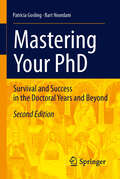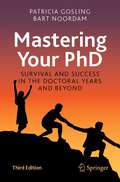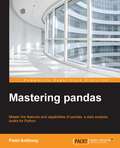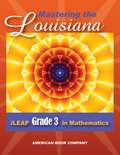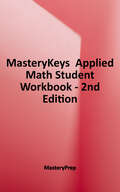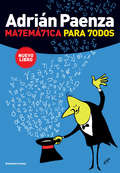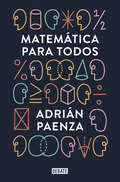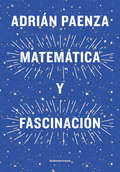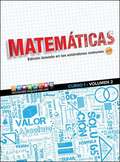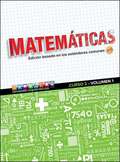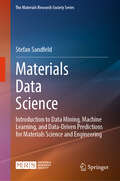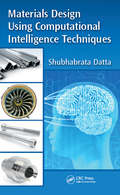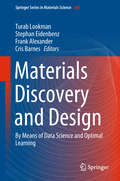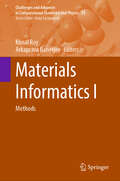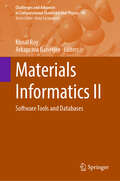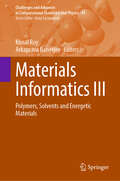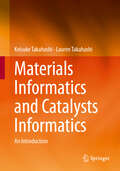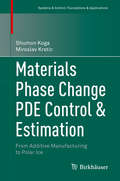- Table View
- List View
Mastering Your PhD
by Lambertus D. Noordam Patricia Gosling"Mastering Your PhD: Survival and Success in the Doctoral Years and Beyond" helps guide PhD students through their graduate student years. Filled with practical advice on getting started, communicating with your supervisor, staying the course, and planning for the future, this book is a handy guide for graduate students who need that extra bit of help getting started and making it through. While mainly directed at PhD students in the sciences, the book's scope is broad enough to encompass the obstacles and hurdles that almost all PhD students face during their doctoral training. Who should read this book? Students of the physical and life sciences, computer science, math, and medicine who are thinking about entering a PhD program; doctoral students at the beginning of their research; and any graduate student who is feeling frustrated and stuck. It's never too early -- or too late! This second edition contains a variety of new material, including additional chapters on how to communicate better with your supervisor, dealing with difficult people, how to find a mentor, and new chapters on your next career step, once you have your coveted doctoral degree in hand.
Mastering Your PhD: Survival and Success in the Doctoral Years and Beyond
by Patricia Gosling Bart NoordamThis bestselling book guides PhD students through their graduate years and beyond. Filled with practical advice on getting started, communicating with your supervisor, staying the course, and planning for the future, this book is an indispensable guide for graduate students who need that extra bit of help getting started and making it through. Who should read this book? Any student currently in, or curious about, a PhD programme, be it in the physical and life sciences, engineering, computer science, math, medicine, or the humanities — this book tackles the obstacles and hurdles that almost all PhD students face during their doctoral training. Whether you’re at the very beginning of your research, close to the end, or just feeling frustrated and stuck at any point in between…it’s never too early — or too late — to focus on your success! This third edition contains a variety of new material, including additional chapters and advice on how to make the most of remote learning, collaboration, and communication tools, as well as updated material on your next career step once you have your coveted doctoral degree in hand. Some of the material in the third edition appeared as part of a monthly column on the ScienceCareers website.
Mastering pandas
by Femi AnthonyThis book is intended for Python programmers, mathematicians, and analysts who already have a basic understanding of Python and wish to learn about its data analysis capabilities in depth.
Mastering the Louisiana iLEAP Grade 3 in Mathematics
by Erica Day Colleen Pintozzi Mary ReaganMastering the Louisiana iLEAP Grade 3 in Mathematics will help you review and learn important concepts and skills related to 3rd grade mathematics.
Mastery Mathematics for Primary Teachers
by Robert NewellThis book examines how mathematical mastery, influenced by East Asian teaching approaches, can be developed in UK schools to enhance teaching and to deepen children’s mathematical knowledge. It gives guidance on using physical resources to demonstrate key concepts, extended examples on how to teach different curriculum topics and how to plan for small-step progression. It argues that effective mastery teaching requires careful and knowledgeable support for primary teachers who may not yet be maths specialists. New to this second edition: New chapter on variation theory and practice Updated case studies exploring how mastery teaching has evolved Updated review of current mastery resources available to UK teachers Robert Newell is a lecturer at the UCL Institute of Education, London.
Mastery Mathematics for Primary Teachers
by Robert NewellThis book examines how mathematical mastery, influenced by East Asian teaching approaches, can be developed in UK schools to enhance teaching and to deepen children’s mathematical knowledge. It gives guidance on using physical resources to demonstrate key concepts, extended examples on how to teach different curriculum topics and how to plan for small-step progression. It argues that effective mastery teaching requires careful and knowledgeable support for primary teachers who may not yet be maths specialists. New to this second edition: New chapter on variation theory and practice Updated case studies exploring how mastery teaching has evolved Updated review of current mastery resources available to UK teachers Robert Newell is a lecturer at the UCL Institute of Education, London.
MasteryKeys: Applied Math Student Workbook
by MasteryPrepFrom this book you will learn addition, subtraction, multiplication, and division. You will learn how to convert numbers between fractions, decimals, and percentages. Lastly, you will learn how to solve problems dealing with negative numbers, money, and time.
Matemática para todos
by Adrián PaenzaEl padre de la matemática recreativa en la Argentina nos desafía con másjuegos, problemas y enigmas. Con problemas de lógica, estrategia, probabilidades e intuición, AdriánPaenza nos desafía una vez más a pensar y animarnos a jugar a lamatemágica. Como dijo Richard Hamming: «Conocimiento y productividad soncomo el interés compuesto. Dadas dos personas con -aproximadamente- lamisma habilidad, si una de ellas trabaja un diez por ciento más que laotra, la que trabaja más va a terminar por producir más del doble que laotra. Cuanto más sabés, más aprendés. Cuanto más aprendés, más podéshacer. Cuanto más podés hacer, más oportunidades vas a tener. Funcionacomo el interés compuesto. No quiero dar un número porque no es algoexacto, pero dadas dos personas con la misma habilidad, la persona quepueda dedicarle todos los días una hora más a pensar que la otra, va aterminar siendo muchísimo más productiva en comparación a lo largo de lavida». Pensar, nos educa. «Matemática para todos» es el nuevo aporte deAdrián Paenza a la divulgación de la matemática.
Matemática para todos
by Adrián PaenzaAdrián Paenza, ganador del premio Leelavati al mejor divulgador de matemáticas del mundo y autor de exitosos títulos como Matemagia o ¿Pero esto también es matemática? , nos desafía una vez más a pensar con nuevos problemas de lógica, estrategia, probabilidades e intuición. Como dijo Richard Hamming: «Conocimiento y productividad son como el interés compuesto. Dadas dos personas con -aproximadamente- la misma habilidad, si una de ellas trabaja un diez por ciento más que la otra, la que trabaja más va a terminar por producir más del doble que la otra. Cuanto más sabes, más aprendes. Cuanto más aprendes, más puedes hacer. Cuanto más puedes hacer, más oportunidades vas a tener. Funciona como el interés compuesto. No quiero dar un número porque no es algo exacto, pero dadas dos personas con la misma habilidad, la persona que pueda dedicarle todos los días una hora más a pensar que la otra, va a terminar siendo muchísimo más productiva en comparación a lo largo de la vida». Pensar nos educa y Matemática para todos es el nuevo aporte de Adrián Paenza a la divulgación de las matemáticas.
Matemática y fascinación
by Adrián PaenzaAdrián Paenza nos invita a bajar un cambio y pasar un tiempo con nosotros mismos para hacer matemática como los matemáticos. La matemática está presente todos los días en cada momento de nuestras vidas y hasta nos sirve para tomar decisiones difíciles. Pero también es capaz de jugar con nuestra curiosidad para sorprendernos y fascinarnos como cuando éramos niños. Baje un cambio y disfrute de este libro: conozca los números narcisistas y resuelva problemas tendenciosos. Descubra un mensaje encriptado. Cuente con los dedos de las dos manos hasta mucho más de mil. Atrévase a presentar a su familia o amigos un pase de magia. Diviértase con el póquer de la vida real. Deje que se le ponga la piel de gallina con la extraordinaria historia de las hermanas ajedrecistas... En fin, haga matemática como los matemáticos. Anímese a pasar un tiempo con usted mismo para desafiarse. ¡Vale la pena!
Matemáticas: Edición basada en los estándares comunes, CCSS, Curso 1, Volumen 1 (Math Applic And Conn Crse Ser.)
by Day Carter CuevasNIMAC-sourced textbook
Matemáticas: Edición basada en los estándares comunes, CCSS, Curso 1, Volumen 2 (Math Applic And Conn Crse Ser.)
by Day Carter CuevasNIMAC-sourced textbook
Matemáticas: Edición basada en los estándares comunes, CCSS, Curso 2, Volumen 1
by Day Carter CuevasNIMAC-sourced textbook
Matemáticas: Edición basada en los estándares comunes, CCSS, Curso 3, Volumen 1 (Math Applic And Conn Crse Ser.)
by Day Carter CuevasNIMAC-sourced textbook
Matemáticas: Edición basada en los estándares comunes, CCSS, Curso 3, Volumen 2 (Math Applic And Conn Crse Ser.)
by Day Carter CuevasNIMAC-sourced textbook
Material Inhomogeneities in Elasticity
by G.A. MauginSelf contained, this book presents a thorough introduction to the complementary notions of physical forces and material (or configurational) forces. All the required elements of continuum mechanics, deformation theory and differential geometry are also covered. This book will be a great help to many, whilst revealing to others a rather new facet of continuum mechanics in general, and elasticity in particular. An organized exposition of continuum mechanics on the material manifold is given which allows for the consideration of material inhomogeneities in their most appropriate framework. In such a frame the nonlinear elasticity of anisotropic inhomogenous materials appears to be a true field theory. Extensions to the cases of electroelasticity and magnetelasticity are then straightforward. In addition, this original approach provides systematic computational means for the evaluation of characteristic parameters which are useful in various branches of applied mechanics and mathematical physics. This is the case for path-independent integrals and energy-release rates in brittle fracture, the influence of electromagnetic fields on fracture criteria (such as in ceramics), the notion of momentum of electromagnetic fields in matter in optics, and the perturbation of solitons propagating in elastic dispersive systems.
Materials Data Science: Introduction to Data Mining, Machine Learning, and Data-Driven Predictions for Materials Science and Engineering (The Materials Research Society Series)
by Stefan SandfeldThis text covers all of the data science, machine learning, and deep learning topics relevant to materials science and engineering, accompanied by numerous examples and applications. Almost all methods and algorithms introduced are implemented “from scratch” using Python and NumPy. The book starts with an introduction to statistics and probabilities, explaining important concepts such as random variables and probability distributions, Bayes’ theorem and correlations, sampling techniques, and exploratory data analysis, and puts them in the context of materials science and engineering. Therefore, it serves as a valuable primer for both undergraduate and graduate students, as well as a review for research scientists and practicing engineers. The second part provides an in-depth introduction of (statistical) machine learning. It begins with outlining fundamental concepts and proceeds to explore a variety of supervised learning techniques for regression and classification, including advanced methods such as kernel regression and support vector machines. The section on unsupervised learning emphasizes principal component analysis, and also covers manifold learning (t-SNE and UMAP) and clustering techniques. Additionally, feature engineering, feature importance, and cross-validation are introduced. The final part on neural networks and deep learning aims to promote an understanding of these methods and dispel misconceptions that they are a “black box”. The complexity gradually increases until fully connected networks can be implemented. Advanced techniques and network architectures, including GANs, are implemented “from scratch” using Python and NumPy, which facilitates a comprehensive understanding of all the details and enables the user to conduct their own experiments in Deep Learning.
Materials Design Using Computational Intelligence Techniques
by Shubhabrata DattaSeveral statistical techniques are used for the design of materials through extraction of knowledge from existing data banks. These approaches are getting more attention with the application of computational intelligence techniques. This book illustrates the alternative but effective methods of designing materials, where models are developed through capturing the inherent correlations among the variables on the basis of available imprecise knowledge in the form of rules or database, as well as through the extraction of knowledge from experimental or industrial database, and using optimization tools.
Materials Discovery and Design: By Means of Data Science and Optimal Learning (Springer Series in Materials Science #280)
by Turab Lookman Frank Alexander Stephan Eidenbenz Cris BarnesThis book addresses the current status, challenges and future directions of data-driven materials discovery and design. It presents the analysis and learning from data as a key theme in many science and cyber related applications. The challenging open questions as well as future directions in the application of data science to materials problems are sketched. Computational and experimental facilities today generate vast amounts of data at an unprecedented rate. The book gives guidance to discover new knowledge that enables materials innovation to address grand challenges in energy, environment and security, the clearer link needed between the data from these facilities and the theory and underlying science. The role of inference and optimization methods in distilling the data and constraining predictions using insights and results from theory is key to achieving the desired goals of real time analysis and feedback. Thus, the importance of this book lies in emphasizing that the full value of knowledge driven discovery using data can only be realized by integrating statistical and information sciences with materials science, which is increasingly dependent on high throughput and large scale computational and experimental data gathering efforts. This is especially the case as we enter a new era of big data in materials science with the planning of future experimental facilities such as the Linac Coherent Light Source at Stanford (LCLS-II), the European X-ray Free Electron Laser (EXFEL) and MaRIE (Matter Radiation in Extremes), the signature concept facility from Los Alamos National Laboratory. These facilities are expected to generate hundreds of terabytes to several petabytes of in situ spatially and temporally resolved data per sample. The questions that then arise include how we can learn from the data to accelerate the processing and analysis of reconstructed microstructure, rapidly map spatially resolved properties from high throughput data, devise diagnostics for pattern detection, and guide experiments towards desired targeted properties. The authors are an interdisciplinary group of leading experts who bring the excitement of the nascent and rapidly emerging field of materials informatics to the reader.
Materials Informatics I: Methods (Challenges and Advances in Computational Chemistry and Physics #39)
by Kunal Roy Arkaprava BanerjeeThis contributed volume explores the integration of machine learning and cheminformatics within materials science, focusing on predictive modeling techniques. It begins with foundational concepts in materials informatics and cheminformatics, emphasizing quantitative structure-property relationships (QSPR). The volume then presents various methods and tools, including advanced QSPR models, quantitative read-across structure-property relationship (q-RASPR) models, optimization strategies with minimal data, and in silico studies using different descriptors. Additionally, it explores machine learning algorithms and their applications in materials science, alongside innovative modeling approaches for quantum-theoretic properties. Overall, the book serves as a comprehensive resource for understanding and applying machine learning in the study and development of advanced materials and is a useful tool for students, researchers and professionals working in these areas.
Materials Informatics II: Software Tools and Databases (Challenges and Advances in Computational Chemistry and Physics #40)
by Kunal Roy Arkaprava BanerjeeThis contributed volume explores the application of machine learning in predictive modeling within the fields of materials science, nanotechnology, and cheminformatics. It covers a range of topics, including electronic properties of metal nanoclusters, carbon quantum dots, toxicity assessments of nanomaterials, and predictive modeling for fullerenes and perovskite materials. Additionally, the book discusses multiscale modeling and advanced decision support systems for nanomaterial risk management, while also highlighting various machine learning tools, databases, and web platforms designed to predict the properties of materials and molecules. It is a comprehensive guide and a great tool for researchers working at the intersection of machine learning and material sciences.
Materials Informatics III: Polymers, Solvents and Energetic Materials (Challenges and Advances in Computational Chemistry and Physics #41)
by Kunal Roy Arkaprava BanerjeeThis contributed volume focuses on the application of machine learning and cheminformatics in predictive modeling for organic materials, polymers, solvents, and energetic materials. It provides an in-depth look at how machine learning is utilized to predict key properties of polymers, deep eutectic solvents, and ionic liquids, as well as to improve safety and performance in the study of energetic and reactive materials. With chapters covering polymer informatics, quantitative structure–property relationship (QSPR) modeling, and computational approaches, the book serves as a comprehensive resource for researchers applying predictive modeling techniques to advance materials science and improve material safety and performance.
Materials Informatics and Catalysts Informatics: An Introduction
by Keisuke Takahashi Lauren TakahashiThis textbook is designed for students and researchers who are interested in materials and catalysts informatics with little to no prior experience in data science or programming languages. Starting with a comprehensive overview of the concept and historical context of materials and catalysts informatics, it serves as a guide for establishing a robust materials informatics environment. This essential resource is designed to teach vital skills and techniques required for conducting informatics-driven research, including the intersection of hardware, software, programming, machine learning within the field of data science and informatics. Readers will explore fundamental programming techniques, with a specific focus on Python, a versatile and widely-used language in the field. The textbook explores various machine learning techniques, equipping learners with the knowledge to harness the power of data science effectively. The textbook provides Python code examples, demonstrating materials informatics applications, and offers a deeper understanding through real-world case studies using materials and catalysts data. This practical exposure ensures readers are fully prepared to embark on their informatics-driven research endeavors upon completing the textbook. Instructors will also find immense value in this resource, as it consolidates the skills and information required for materials informatics into one comprehensive repository. This streamlines the course development process, significantly reducing the time spent on creating course material. Instructors can leverage this solid foundation to craft engaging and informative lecture content, making the teaching process more efficient and effective.
Materials Interaction with Femtosecond Lasers: Theory and Ultra-Large-Scale Simulations of Thermal and Nonthermal Pheomena
by Bernd BauerhenneThis book presents a unified view of the response of materials as a result of femtosecond laser excitation, introducing a general theory that captures both ultrashort-time non-thermal and long-time thermal phenomena. It includes a novel method for performing ultra-large-scale molecular dynamics simulations extending into experimental and technological spatial dimensions with ab-initio precision. For this, it introduces a new class of interatomic potentials, constructed from ab-initio data with the help of a self-learning algorithm, and verified by direct comparison with experiments in two different materials — the semiconductor silicon and the semimetal antimony.In addition to a detailed description of the new concepts introduced, as well as giving a timely review of ultrafast phenomena, the book provides a rigorous introduction to the field of laser–matter interaction and ab-initio description of solids, delivering a complete and self-contained examination of the topic from the very first principles. It explains, step by step from the basic physical principles, the underlying concepts in quantum mechanics, solid-state physics, thermodynamics, statistical mechanics, and electrodynamics, introducing all necessary mathematical theorems as well as their proofs. A collection of appendices provide the reader with an appropriate review of many fundamental mathematical concepts, as well as important analytical and numerical parameters used in the simulations.
Materials Phase Change PDE Control & Estimation: From Additive Manufacturing to Polar Ice (Systems & Control: Foundations & Applications)
by Miroslav Krstic Shumon KogaThis monograph introduces breakthrough control algorithms for partial differential equation models with moving boundaries, the study of which is known as the Stefan problem. The algorithms can be used to improve the performance of various processes with phase changes, such as additive manufacturing. Using the authors' innovative design solutions, readers will also be equipped to apply estimation algorithms for real-world phase change dynamics, from polar ice to lithium-ion batteries.A historical treatment of the Stefan problem opens the book, situating readers in the larger context of the area. Following this, the chapters are organized into two parts. The first presents the design method and analysis of the boundary control and estimation algorithms. Part two then explores a number of applications, such as 3D printing via screw extrusion and laser sintering, and also discusses the experimental verifications conducted. A number of open problems and provided as well, offering readers multiple paths to explore in future research.Materials Phase Change PDE Control & Estimation is ideal for researchers and graduate students working on control and dynamical systems, and particularly those studying partial differential equations and moving boundaries. It will also appeal to industrial engineers and graduate students in engineering who are interested in this area.
